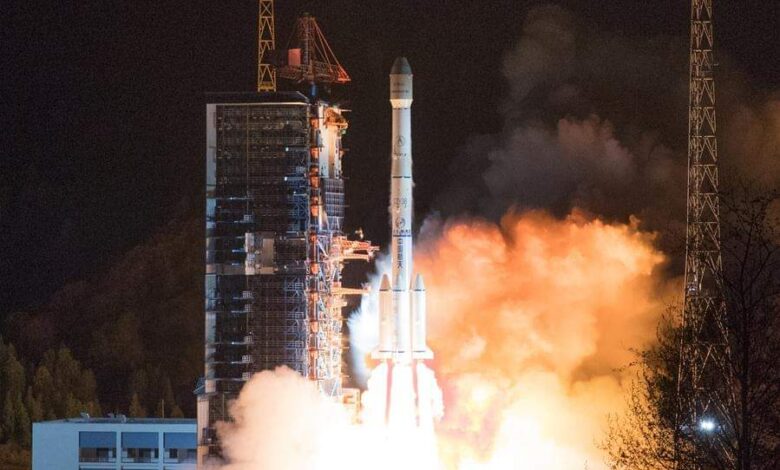China’s Breakthrough: Successful Ground Test of Grid Fins for Next-Gen Manned Rockets
The Role of Grid Fins in Landing Control:

China’s Breakthrough: Successful Ground Test of Grid Fins for Next-Gen Manned Rockets
Introduction: China has recently achieved a significant milestone in its space exploration endeavors. The nation has accomplished a successful proof-of-principle ground test for the grid fins, which are an integral part of the landing control system for the new generation of manned rockets.
Notably, these grid fins are the largest currently being researched in China. This remarkable achievement brings China one step closer to realizing its vision of developing reusable launch vehicles, bolstering the country’s position in the global space race.
In this blog post, we will delve into the details of China’s groundbreaking achievement and explore the importance of grid fins in the context of landing control for reusable rockets.
The Role of Grid Fins in Landing Control: Grid fins are advanced aerodynamic control surfaces designed to provide stability and maneuverability during the descent phase of reusable launch vehicles. They consist of a lattice-like structure that can be extended or retracted as needed to manipulate the airflow and control the vehicle’s trajectory.
The successful ground test of grid fins conducted by China is a significant breakthrough because these fins are crucial for achieving controlled and precise landings. By adjusting the grid fins’ positions, the rocket can control its descent and make necessary adjustments to ensure a safe touchdown. This technology is pivotal in developing reusable launch vehicles, as it enables rockets to return to Earth intact, reducing costs and allowing for more frequent space missions.
China’s Advancements in Grid Fin Technology: China has been steadily advancing its space exploration capabilities and investing heavily in cutting-edge technologies. The recent ground test of the grid fins is a testament to the nation’s progress in this domain. The grid fins tested are the largest under research in China, indicating the country’s commitment to pushing the boundaries of innovation.
Through meticulous engineering and rigorous testing, Chinese scientists and engineers have successfully developed grid fins that meet the stringent requirements of landing control. The ground test serves as a proof-of-principle, demonstrating the viability and effectiveness of China’s grid fin technology.
Implications for China’s Space Program: The successful ground test of grid fins holds immense significance for China’s space program. It signifies a crucial step towards achieving the country’s long-term goal of developing reusable launch vehicles. By mastering the art of controlled landings, China can significantly reduce the costs associated with space missions and increase operational efficiency.
Reusable launch vehicles have the potential to revolutionize space exploration by enabling more frequent launches, facilitating the deployment of satellites, and supporting manned missions to space. China’s progress in grid fin technology brings the nation closer to establishing a sustainable space program capable of exploring new frontiers and conducting scientific research on a larger scale.
Conclusion: China’s recent accomplishment in conducting a proof-of-principle ground test for the grid fins of next-generation manned rockets is a remarkable achievement. This success paves the way for the development of reusable launch vehicles, putting China at the forefront of the global space race. The grid fins, being the largest under research in China, play a pivotal role in the landing control of these rockets, ensuring controlled and precise descents.
With its continuous advancements in space technology, China is poised to make significant contributions to space exploration. The successful ground test of grid fins brings the nation one step closer to realizing its ambitions of establishing a sustainable and efficient space program.
As China continues to push boundaries and innovate, the future of space exploration holds immense promise, with the potential for groundbreaking discoveries and unprecedented achievements.
The Role of Grid Fins in Landing Control:
Grid fins play a critical role in the landing control of reusable launch vehicles. These advanced aerodynamic control surfaces are specifically designed to provide stability and maneuverability during the descent phase, ensuring a controlled and precise landing. Let’s take a closer look at how grid fins function and their significance in landing control.
Aerodynamic Stability: During reentry, the atmosphere exerts tremendous forces on a descending rocket, which can cause it to become unstable. Grid fins counteract these forces by generating aerodynamic lift and stabilizing the vehicle. The lattice-like structure of grid fins creates vortices and directs the airflow, enabling the rocket to maintain stability even under turbulent conditions.
Trajectory Control: The extendable and retractable nature of grid fins allows for precise control over the vehicle’s trajectory during descent. By manipulating the grid fins’ positions, the rocket can adjust its flight path, making necessary corrections to ensure it reaches the intended landing site. This level of control is essential for achieving pinpoint accuracy in landing and avoiding obstacles or hazardous areas.
Maneuverability: Grid fins provide the necessary maneuverability for the rocket to perform complex flight maneuvers during descent. By adjusting the grid fins asymmetrically, the vehicle can execute pitch, yaw, and roll motions, allowing it to align itself with the desired landing orientation. This capability is particularly important for landing on offshore platforms, moving ships, or in situations where precise positioning is crucial.
Heat Dissipation: During reentry, the intense heat generated by atmospheric friction poses a significant challenge. Grid fins not only provide aerodynamic control but also assist in heat dissipation. The lattice-like structure promotes airflow through the fins, effectively cooling the rocket’s surfaces and preventing excessive heating.
Reusability and Cost Reduction: One of the primary objectives of grid fins is to enable the development of reusable launch vehicles. By ensuring controlled landings, these fins allow rockets to touch down intact, minimizing damage and facilitating refurbishment for subsequent launches. Reusability drastically reduces the costs associated with space missions, making them more economically viable and promoting increased access to space.
In conclusion, grid fins play a pivotal role in landing control for reusable launch vehicles. Their ability to provide stability, precise trajectory control, maneuverability, heat dissipation, and support reusability contributes significantly to the efficiency and cost-effectiveness of space missions. As advancements in grid fin technology continue to be made, we can expect further progress in the development of reusable rockets, ultimately revolutionizing the future of space exploration
When a rocket undergoes reentry into the Earth’s atmosphere, it encounters a significant amount of aerodynamic forces that can lead to instability. However, grid fins are specifically designed to counteract these forces and ensure aerodynamic stability throughout the descent phase. By generating aerodynamic lift and manipulating the airflow, grid fins play a crucial role in stabilizing the vehicle. Here’s a closer look at how grid fins achieve aerodynamic stability:
Countering Forces: During reentry, a rocket experiences various forces, including drag, gravity, and atmospheric pressure. These forces can cause the rocket to tumble, roll, or deviate from its intended trajectory. Grid fins help counteract these forces by generating aerodynamic lift, which acts opposite to the force of gravity. This lift force provides upward support and helps maintain the rocket’s stability during descent.
Lattice-like Structure: Grid fins are characterized by their lattice-like structure, consisting of interconnected struts or vanes. This design allows for the creation of vortices, which are swirling patterns of airflow generated by the fins. As the rocket descends, these vortices redirect the airflow around the grid fins, effectively manipulating the forces acting upon the vehicle.
Airflow Control: The lattice-like structure of grid fins enables precise control over the direction and intensity of airflow. By adjusting the grid fins’ position and angle, the rocket can influence the vortices’ formation and redirect the airflow to counteract destabilizing forces. This control over the airflow helps the rocket maintain stability, even in turbulent or dynamic atmospheric conditions.
Stability Under Turbulence: Reentry into the Earth’s atmosphere can subject a descending rocket to turbulent conditions. Turbulence can result from variations in atmospheric density, wind shear, or other factors. The grid fins’ ability to create vortices and manipulate the airflow allows the rocket to mitigate the effects of turbulence and maintain stability throughout the descent phase.
By effectively countering the destabilizing forces and manipulating the airflow, grid fins contribute significantly to the aerodynamic stability of a descending rocket. This stability ensures a controlled and safe descent, facilitating precise landing control and reducing the risk of damage or mission failure.
In summary, grid fins play a vital role in maintaining aerodynamic stability during the reentry and descent of rockets. Through the generation of aerodynamic lift and the manipulation of airflow using their lattice-like structure, grid fins counteract destabilizing forces and help the rocket maintain a stable trajectory. This stability is crucial for safe and controlled landings, contributing to the success of space missions and the development of reusable launch vehicles.
When a rocket undergoes reentry into the Earth’s atmosphere, it encounters several forces that can disrupt its stability and trajectory. These forces include drag, gravity, and atmospheric pressure. However, grid fins play a crucial role in countering these forces and ensuring the rocket maintains stability during descent. Here’s a closer look at how grid fins counteract the forces acting on a descending rocket:
Drag Reduction: Drag is the resistance encountered by a rocket as it moves through the atmosphere. During reentry, the drag force can cause the rocket to slow down and deviate from its intended path. Grid fins are designed to minimize drag by optimizing the airflow around the rocket. The lattice-like structure of the grid fins helps control and manipulate the airflow, reducing drag and allowing the rocket to maintain its speed and trajectory.
Aerodynamic Lift: Grid fins generate aerodynamic lift, which acts opposite to the force of gravity. This lift force provides upward support to counteract the downward pull of gravity, helping the rocket maintain its stability and prevent excessive descent rates. By generating lift, the grid fins assist in balancing the forces acting on the rocket and ensuring a controlled descent.
Stability Control: The aerodynamic lift generated by the grid fins not only counteracts gravity but also provides stability control during descent. By adjusting the position and angle of the grid fins, the lift force can be directed to stabilize the rocket. This stability control helps prevent tumbling, rolling, or deviation from the intended trajectory, enabling a controlled and precise descent.
Atmospheric Pressure Management: During reentry, the rocket experiences varying atmospheric pressure as it moves through different layers of the atmosphere. These pressure changes can exert significant forces on the rocket.
Grid fins aid in managing the effects of atmospheric pressure by manipulating the airflow and redistributing the pressure forces around the vehicle. This helps maintain the rocket’s stability and minimizes the potential for disruptive forces.
By countering the forces of drag, gravity, and atmospheric pressure, grid fins ensure that a descending rocket remains stable and maintains its intended trajectory.
The generation of aerodynamic lift by the grid fins provides upward support, effectively balancing the downward forces and allowing for a controlled descent. With the assistance of grid fins, rockets can navigate through the atmosphere more efficiently and achieve safe and precise landings.
In summary, grid fins play a crucial role in countering the forces experienced by a rocket during reentry. By reducing drag, generating aerodynamic lift, and providing stability control, grid fins enable a descending rocket to maintain stability, ensuring a controlled descent and successful landing.
arewanahiya.com







